In my app I'm trying to do face recognition on a specific image using Open CV, here first I'm training one image and then after training that image if I run face recognition on that image it successfully recognizes that trained face. However, when I turn to another picture of the same person recognition does not work. It just works on the trained image, so my question is how do I rectify it?
Update: What i want to do is that user should select image of a person from storage and then after training that selected image i want to fetch all images from storage which matches face of my trained image
Here is my activity class:
public class MainActivity extends AppCompatActivity {
private Mat rgba,gray;
private CascadeClassifier classifier;
private MatOfRect faces;
private ArrayList<Mat> images;
private ArrayList<String> imagesLabels;
private Storage local;
ImageView mimage;
Button prev,next;
ArrayList<Integer> imgs;
private int label[] = new int[1];
private double predict[] = new double[1];
Integer pos = 0;
private String[] uniqueLabels;
FaceRecognizer recognize;
private boolean trainfaces() {
if(images.isEmpty())
return false;
List<Mat> imagesMatrix = new ArrayList<>();
for (int i = 0; i < images.size(); i++)
imagesMatrix.add(images.get(i));
Set<String> uniqueLabelsSet = new HashSet<>(imagesLabels); // Get all unique labels
uniqueLabels = uniqueLabelsSet.toArray(new String[uniqueLabelsSet.size()]); // Convert to String array, so we can read the values from the indices
int[] classesNumbers = new int[uniqueLabels.length];
for (int i = 0; i < classesNumbers.length; i++)
classesNumbers[i] = i + 1; // Create incrementing list for each unique label starting at 1
int[] classes = new int[imagesLabels.size()];
for (int i = 0; i < imagesLabels.size(); i++) {
String label = imagesLabels.get(i);
for (int j = 0; j < uniqueLabels.length; j++) {
if (label.equals(uniqueLabels[j])) {
classes[i] = classesNumbers[j]; // Insert corresponding number
break;
}
}
}
Mat vectorClasses = new Mat(classes.length, 1, CvType.CV_32SC1); // CV_32S == int
vectorClasses.put(0, 0, classes); // Copy int array into a vector
recognize = LBPHFaceRecognizer.create(3,8,8,8,200);
recognize.train(imagesMatrix, vectorClasses);
if(SaveImage())
return true;
return false;
}
public void cropedImages(Mat mat) {
Rect rect_Crop=null;
for(Rect face: faces.toArray()) {
rect_Crop = new Rect(face.x, face.y, face.width, face.height);
}
Mat croped = new Mat(mat, rect_Crop);
images.add(croped);
}
public boolean SaveImage() {
File path = new File(Environment.getExternalStorageDirectory(), "TrainedData");
path.mkdirs();
String filename = "lbph_trained_data.xml";
File file = new File(path, filename);
recognize.save(file.toString());
if(file.exists())
return true;
return false;
}
private BaseLoaderCallback callbackLoader = new BaseLoaderCallback(this) {
@Override
public void onManagerConnected(int status) {
switch(status) {
case BaseLoaderCallback.SUCCESS:
faces = new MatOfRect();
//reset
images = new ArrayList<Mat>();
imagesLabels = new ArrayList<String>();
local.putListMat("images", images);
local.putListString("imagesLabels", imagesLabels);
images = local.getListMat("images");
imagesLabels = local.getListString("imagesLabels");
break;
default:
super.onManagerConnected(status);
break;
}
}
};
@Override
protected void onResume() {
super.onResume();
if(OpenCVLoader.initDebug()) {
Log.i("hmm", "System Library Loaded Successfully");
callbackLoader.onManagerConnected(BaseLoaderCallback.SUCCESS);
} else {
Log.i("hmm", "Unable To Load System Library");
OpenCVLoader.initAsync(OpenCVLoader.OPENCV_VERSION, this, callbackLoader);
}
}
@Override
protected void onCreate(Bundle savedInstanceState) {
super.onCreate(savedInstanceState);
setContentView(R.layout.activity_main);
prev = findViewById(R.id.btprev);
next = findViewById(R.id.btnext);
mimage = findViewById(R.id.mimage);
local = new Storage(this);
imgs = new ArrayList();
imgs.add(R.drawable.jonc);
imgs.add(R.drawable.jonc2);
imgs.add(R.drawable.randy1);
imgs.add(R.drawable.randy2);
imgs.add(R.drawable.imgone);
imgs.add(R.drawable.imagetwo);
mimage.setBackgroundResource(imgs.get(pos));
prev.setOnClickListener(new View.OnClickListener() {
@Override
public void onClick(View view) {
if(pos!=0){
pos--;
mimage.setBackgroundResource(imgs.get(pos));
}
}
});
next.setOnClickListener(new View.OnClickListener() {
@Override
public void onClick(View view) {
if(pos<5){
pos++;
mimage.setBackgroundResource(imgs.get(pos));
}
}
});
Button train = (Button)findViewById(R.id.btn_train);
train.setOnClickListener(new View.OnClickListener() {
@RequiresApi(api = Build.VERSION_CODES.KITKAT)
@Override
public void onClick(View view) {
rgba = new Mat();
gray = new Mat();
Mat mGrayTmp = new Mat();
Mat mRgbaTmp = new Mat();
classifier = FileUtils.loadXMLS(MainActivity.this);
Bitmap icon = BitmapFactory.decodeResource(getResources(),
imgs.get(pos));
Bitmap bmp32 = icon.copy(Bitmap.Config.ARGB_8888, true);
Utils.bitmapToMat(bmp32, mGrayTmp);
Utils.bitmapToMat(bmp32, mRgbaTmp);
Imgproc.cvtColor(mGrayTmp, mGrayTmp, Imgproc.COLOR_BGR2GRAY);
Imgproc.cvtColor(mRgbaTmp, mRgbaTmp, Imgproc.COLOR_BGRA2RGBA);
/*Core.transpose(mGrayTmp, mGrayTmp); // Rotate image
Core.flip(mGrayTmp, mGrayTmp, -1); // Flip along both*/
gray = mGrayTmp;
rgba = mRgbaTmp;
Imgproc.resize(gray, gray, new Size(200,200.0f/ ((float)gray.width()/ (float)gray.height())));
if(gray.total() == 0)
Toast.makeText(getApplicationContext(), "Can't Detect Faces", Toast.LENGTH_SHORT).show();
classifier.detectMultiScale(gray,faces,1.1,3,0|CASCADE_SCALE_IMAGE, new Size(30,30));
if(!faces.empty()) {
if(faces.toArray().length > 1)
Toast.makeText(getApplicationContext(), "Mutliple Faces Are not allowed", Toast.LENGTH_SHORT).show();
else {
if(gray.total() == 0) {
Log.i("hmm", "Empty gray image");
return;
}
cropedImages(gray);
imagesLabels.add("Baby");
Toast.makeText(getApplicationContext(), "Picture Set As Baby", Toast.LENGTH_LONG).show();
if (images != null && imagesLabels != null) {
local.putListMat("images", images);
local.putListString("imagesLabels", imagesLabels);
Log.i("hmm", "Images have been saved");
if(trainfaces()) {
images.clear();
imagesLabels.clear();
}
}
}
}else {
/* Bitmap bmp = null;
Mat tmp = new Mat(250, 250, CvType.CV_8U, new Scalar(4));
try {
//Imgproc.cvtColor(seedsImage, tmp, Imgproc.COLOR_RGB2BGRA);
Imgproc.cvtColor(gray, tmp, Imgproc.COLOR_GRAY2RGBA, 4);
bmp = Bitmap.createBitmap(tmp.cols(), tmp.rows(), Bitmap.Config.ARGB_8888);
Utils.matToBitmap(tmp, bmp);
} catch (CvException e) {
Log.d("Exception", e.getMessage());
}*/
/* mimage.setImageBitmap(bmp);*/
Toast.makeText(getApplicationContext(), "Unknown Face", Toast.LENGTH_SHORT).show();
}
}
});
Button recognize = (Button)findViewById(R.id.btn_recognize);
recognize.setOnClickListener(new View.OnClickListener() {
@Override
public void onClick(View view) {
if(loadData())
Log.i("hmm", "Trained data loaded successfully");
rgba = new Mat();
gray = new Mat();
faces = new MatOfRect();
Mat mGrayTmp = new Mat();
Mat mRgbaTmp = new Mat();
classifier = FileUtils.loadXMLS(MainActivity.this);
Bitmap icon = BitmapFactory.decodeResource(getResources(),
imgs.get(pos));
Bitmap bmp32 = icon.copy(Bitmap.Config.ARGB_8888, true);
Utils.bitmapToMat(bmp32, mGrayTmp);
Utils.bitmapToMat(bmp32, mRgbaTmp);
Imgproc.cvtColor(mGrayTmp, mGrayTmp, Imgproc.COLOR_BGR2GRAY);
Imgproc.cvtColor(mRgbaTmp, mRgbaTmp, Imgproc.COLOR_BGRA2RGBA);
/*Core.transpose(mGrayTmp, mGrayTmp); // Rotate image
Core.flip(mGrayTmp, mGrayTmp, -1); // Flip along both*/
gray = mGrayTmp;
rgba = mRgbaTmp;
Imgproc.resize(gray, gray, new Size(200,200.0f/ ((float)gray.width()/ (float)gray.height())));
if(gray.total() == 0)
Toast.makeText(getApplicationContext(), "Can't Detect Faces", Toast.LENGTH_SHORT).show();
classifier.detectMultiScale(gray,faces,1.1,3,0|CASCADE_SCALE_IMAGE, new Size(30,30));
if(!faces.empty()) {
if(faces.toArray().length > 1)
Toast.makeText(getApplicationContext(), "Mutliple Faces Are not allowed", Toast.LENGTH_SHORT).show();
else {
if(gray.total() == 0) {
Log.i("hmm", "Empty gray image");
return;
}
recognizeImage(gray);
}
}else {
Toast.makeText(getApplicationContext(), "Unknown Face", Toast.LENGTH_SHORT).show();
}
}
});
}
private void recognizeImage(Mat mat) {
Rect rect_Crop=null;
for(Rect face: faces.toArray()) {
rect_Crop = new Rect(face.x, face.y, face.width, face.height);
}
Mat croped = new Mat(mat, rect_Crop);
recognize.predict(croped, label, predict);
int indice = (int)predict[0];
Log.i("hmmcheck:",String.valueOf(label[0])+" : "+String.valueOf(indice));
if(label[0] != -1 && indice < 125)
Toast.makeText(getApplicationContext(), "Welcome "+uniqueLabels[label[0]-1]+"", Toast.LENGTH_SHORT).show();
else
Toast.makeText(getApplicationContext(), "You're not the right person", Toast.LENGTH_SHORT).show();
}
private boolean loadData() {
String filename = FileUtils.loadTrained();
if(filename.isEmpty())
return false;
else
{
recognize.read(filename);
return true;
}
}
}
My File Utils Class:
public class FileUtils {
private static String TAG = FileUtils.class.getSimpleName();
private static boolean loadFile(Context context, String cascadeName) {
InputStream inp = null;
OutputStream out = null;
boolean completed = false;
try {
inp = context.getResources().getAssets().open(cascadeName);
File outFile = new File(context.getCacheDir(), cascadeName);
out = new FileOutputStream(outFile);
byte[] buffer = new byte[4096];
int bytesread;
while((bytesread = inp.read(buffer)) != -1) {
out.write(buffer, 0, bytesread);
}
completed = true;
inp.close();
out.flush();
out.close();
} catch (IOException e) {
Log.i(TAG, "Unable to load cascade file" + e);
}
return completed;
}
public static CascadeClassifier loadXMLS(Activity activity) {
InputStream is = activity.getResources().openRawResource(R.raw.lbpcascade_frontalface);
File cascadeDir = activity.getDir("cascade", Context.MODE_PRIVATE);
File mCascadeFile = new File(cascadeDir, "lbpcascade_frontalface_improved.xml");
FileOutputStream os = null;
try {
os = new FileOutputStream(mCascadeFile);
byte[] buffer = new byte[4096];
int bytesRead;
while ((bytesRead = is.read(buffer)) != -1) {
os.write(buffer, 0, bytesRead);
}
is.close();
os.close();
} catch (FileNotFoundException e) {
e.printStackTrace();
} catch (IOException e) {
e.printStackTrace();
}
return new CascadeClassifier(mCascadeFile.getAbsolutePath());
}
public static String loadTrained() {
File file = new File(Environment.getExternalStorageDirectory(), "TrainedData/lbph_trained_data.xml");
return file.toString();
}
}
These are the images i'm trying to compare here face of person is same still in recognition it's not matching!



